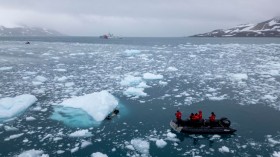The European Space Agency announced that its one-ton satellite re-entered the earth's orbit at about 01:00 CET Monday (19:00 EST).
Update- The satellite reportedly plunged in the Atlantic Ocean. Bill Chater, a Falkland islander, caught the final moments of GOCE's fall on earth, BBC reported.
The satellite's descending path covered Siberia, the western Pacific Ocean, the eastern Indian Ocean and Antarctica, the agency said. There has been no report of any damage to life or property.
Last week, The New York Times had reported that ESA's Gravity Field and Steady-State Ocean Circulation Explorer, or GOCE (pronounced as Go-chay), had run out of propellant on October 21, and was hurling towards the Earth with a speed of 2.5 miles a day.
As predicted, GOCE almost disintegrated completely on its arrival into the orbit. An estimated 25 percent of the satellite reached the surface, ESA said.
"The one-tonne GOCE satellite is only a small fraction of the 100-150 tonnes of man-made space objects that reenter Earth's atmosphere annually," said Heiner Klinkrad, Head of ESA's Space Debris Office.
This isn't the first satellite to fall on earth. In 2011, the media was abuzz with stories of NASA's Upper Atmosphere Research Satellite descent on the planet. In the same year, Russia's Mars mission went awry and crashed into the Pacific.
Anyone who has watched the Sandra Bullock- George Clooney space drama flick 'Gravity' knows that space debris is a huge threat to geostationary satellites. Scientists usually direct redundant satellites to a graveyard orbit, which is just above the GEO orbit. Other satellites are dropped back to earth using specialized equipment to a place called Spacecraft Cemetery.
"In the 56 years of spaceflight, some 15 000 tonnes of man-made space objects have reentered the atmosphere without causing a single human injury to date," Klinkrad said in a news release by ESA.
GOCE's job was to map the earth's gravitational field.
GOCE "Space Ferrari" video courtesy of YouTube:
© 2024 NatureWorldNews.com All rights reserved. Do not reproduce without permission.



![Extreme Heat Wave in Africa’s Sahel Region That Killed 100 People Linked to Climate Change [Study]](https://1471793142.rsc.cdn77.org/data/thumbs/full/70226/280/157/50/40/extreme-heat-wave-in-africa-s-sahel-region-that-killed-100-people-linked-to-climate-change-study.jpg)

